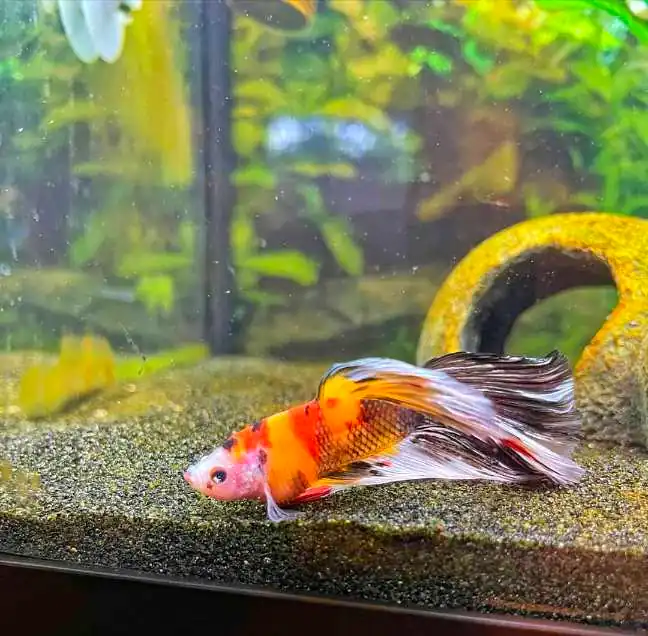Have you noticed your betta looking bloated, with pinecone-like scales, and acting super tired? That’s a scary sign — it might be dropsy. It’s not a disease itself but a serious warning that something’s really wrong inside.
In this guide, you’ll learn what dropsy is, what causes it, and what you can do to help. We’ll walk you through the signs, treatment options, and how to make the kindest choices if things get tough.
What is Dropsy
Dropsy is a condition that indicates internal organ failure or other health issues in fish, often due to an underlying bacterial infection. It is not considered a disease itself but, instead, a symptom of a severe internal health problem.
Symptoms of Dropsy in Betta Fish
A betta fish with dropsy can be identified by several signs, the most common being a swollen belly caused by fluid accumulation inside the fish. This fluid buildup is typically a sign of organ failure, often the kidneys or liver, which are no longer able to regulate fluid balance properly.
Another classic symptom observed in the advanced stage of dropsy is the appearance of pinecone-like scales, which indicates a severe condition of internal organ failure. The scales usually stick out, especially when viewed from the top.

A betta suffering from dropsy may reveal unusual behavior such as lying at the bottom for longer periods than usual or being less responsive to external agents. In some cases, the eyes may poke out more than normal, a condition known as exophthalmos. Refusal to eat, clamped fins, and pale gills are the symptoms of mild to moderate stages of betta dropsy.
Causes of Betta Dropsy
Dropsy is typically caused by bacterial infection, most often by Aeromonas bacteria, which can affect and weaken the betta’s immune system. These bacteria thrive in poor water quality, containing high levels of ammonia, nitrates, and nitrites.
As mentioned above, the unusual swelling of a betta’s abdomen is due to fluid accumulation, which is caused when the kidney of your fish fails to regulate the body fluids. Chronic kidney failure is often caused by insufficient hydration or imbalanced electrolytes in water, which is most prevalent in old-aged bettas.
Other factors that can weaken the immune system include stress from sudden water changes, an improper diet, and overcrowding in the tank—all of which can lead to dropsy in your fish.
Improper diet especially overfeeding causes digestive issues, blockages, and potentially organ stress.
Similarly, cold water often due to the absence of an aquarium heater after a water change, can lead to constipation and potentially causing dropsy in your fish.
Treatment of Betta Dropsy
Like other betta diseases, dropsy should not be cured with medications first, as they often cause side effects. Instead, start by creating a stress-reducing environment and try standard treatments commonly used for other diseases.
Set up the Quarantine Tank
Set up a quarantine tank for your betta with clean, dechlorinated, and well-aerated water, warmer up to 1-2 °F than the usual betta tanks. The quarantine tank should have the same water parameters, such as pH, temperature, and nitrate levels, as your regular betta tank.
To keep stress levels low; turn off the aquarium lights, reduce the filter flow, and avoid anything that might bother your betta.
Salt Treatment
Salt baths can help reduce fluid buildup inside the fish’s body and improve its ability to regulate fluids. For salt treatment, you can use API Aquarium salt, which promotes fish health by improving its respiration. The salt might not completely eliminate the root cause of the disease, but it can still help reduce the secondary effects caused by the disease.
Add one tablespoon for every 5 US gallons or half a tablespoon for every US gallon to the tank. You can try an Epsom salt bath, which helps reduce swelling by drawing out excess fluids. Add one teaspoon of Epsom salt to 1-2 gallons of water and bathe the betta for 15 minutes daily for a minimum of 3 days.
Observe your betta closely for any signs of improvement or worsening. If you see improvement in the betta’s condition, continue with the salt bath. However, if recovery is not evident, especially when dropsy is in advanced stages, proceed with medications without hesitation.
Indian Almond Leaves
Indian almond leaves are known for creating a more natural-looking home for the betta that reduces stress and improves the overall condition of betta. These leaves release the tennis that is believed to have antioxidant properties, which can boost the fish’s immune system.
You can add Indian almond leaves directly to the quarantine tank, one or two leaves per 10 gallons of water. Or boil the leaves in water, then cool the water to a betta tank temperature and add it to the fish betta fish aquarium. You can add algae and alder cones to the tank to introduce tannins.
Medication for Dropsy
Medications are considered the last option to treat fish disease because they can harm betta’s internal organs or stress the delicate betta fish. If the standard treatment is ineffective and there is no option to treat the infection, you can surely treat your fish with medications.
For dropsy, we recommend using the medications as the first priority when you notice that the infection is severe; in this case, salt baths and other things may not be sufficient.
Broad-spectrum antibiotics, such as kanamycin or tetracycline, can be effective against the bacteria causing the dropsy. Seachem Kanaplex has the active ingredient of kanamycin that effectively treats bacterial infections like dropsy and fin rot. It’s too effective for treating internal organs, which is the root cause of dropsy.
The good thing about Kanaplex is that it does not harm beneficial bacteria in your aquarium. It comes in powder form that is easy to dissolve and does not make your tank cloudy.
We have successfully treated my bettas with Melafix by following the correct dosage and administration procedures. Many betta enthusiasts hesitate to use Melafix due to concerns about its Melaleuca ingredient, a tree oil that can harm the labyrinth organ of the fish. However, when properly used with good water circulation and ensuring that the Melaleuca does not float on the water’s surface, Melafix can be beneficial in treating dropsy.
Signs of Recovery
- Disappearance of pineconing
- Reduction of bloating
- No lethargy and more active than before
- Eating as usual
- Disappearance of raised scales
Preventing Your Fish from Dropsy
Preventing dropsy is far more effective than treating it. If your betta develops dropsy, remember there’s a high chance it could return even after treatment. I’ve personally dealt with a betta that had dropsy—I caught it early, and with consistent treatment and proper care afterward, it made a full recovery.
It’s worth noting that the treatment should continue even if the signs of dropsy disappear, as dropsy is often a symptom of underlying internal organ failure. Continuing medication will help treat the root cause within the fish’s body.
Maintain Water Quality
Maintaining high water quality through regular water changes, proper filtration, and monitoring other water parameters such as water temperature (78-80°F) can help prevent your betta from dropsy.
Provide Proper Diet
Provide your betta with a nutritious, balanced diet with different food rotations. Feed your betta high-quality pellets that are explicitly made for them. During the treatment, feed your betta with daphnia and frozen peas, as they have a laxative effect on fish.
However, avoid overfeeding—only give as much as they can finish in a couple of minutes, once or twice a day. Additionally, having one fasting day each week helps with digestion. For added nutrition, you can also mix things up by offering a bit of variety in their diet from time to time.
Minimize Stress
To keep your betta stress-free, use a proper tank size—at least 5 gallons. Add live plants or caves for hiding, avoid sudden water changes, and keep the tank in a quiet spot. Make sure any tank mates are peaceful, or just let your betta live solo. A calm, stable setup helps keep their immune system strong.
Quarantine New Arrivals
Before introducing a new fish into a community tank, quarantine it to look for any signs of ailment and prevent the spread of diseases.
Monitor your betta regularly for signs of illness and take prompt action if symptoms arise. The possibility of dropsy reappearing is higher when a fish has previously suffered from it.
Euthanizing Your Betta Kindly
This is one of the toughest parts of being a fish keeper. Saying goodbye to your betta is heartbreaking, but sometimes it’s the kindest thing you can do when they’re really suffering and not getting better.
When to Think About It
If your betta can’t swim properly, has stopped eating, is clearly in pain, or isn’t responding to treatment, it might be time to consider euthanasia. It’s not giving up—it’s choosing to stop their suffering.
It helps to read up on the process before you’re in an emotional panic. That way, you’ll know what to do if you ever face it.
Best Method – Clove Oil
The clove oil method is gentle and painless. It puts the fish to sleep and then into a deeper sleep until they pass.
Make sure to use 100% pure clove oil. First, mix a few drops in warm water, shake it up really well, then slowly add it to the tank or a small container with the fish. Add more drops gradually until your betta falls into a deep sleep and stops moving completely.
Blunt Force Trauma
This is quick, but it must be done instantly and properly. Honestly, it’s hard to do and not recommended unless you’re absolutely sure you can do it right.
Please don’t flush, freeze, or boil your fish. These are painful and not humane ways to end a life.
It’s okay to cry. It’s okay to feel guilty. But choosing a peaceful goodbye is one last act of love for your betta.




